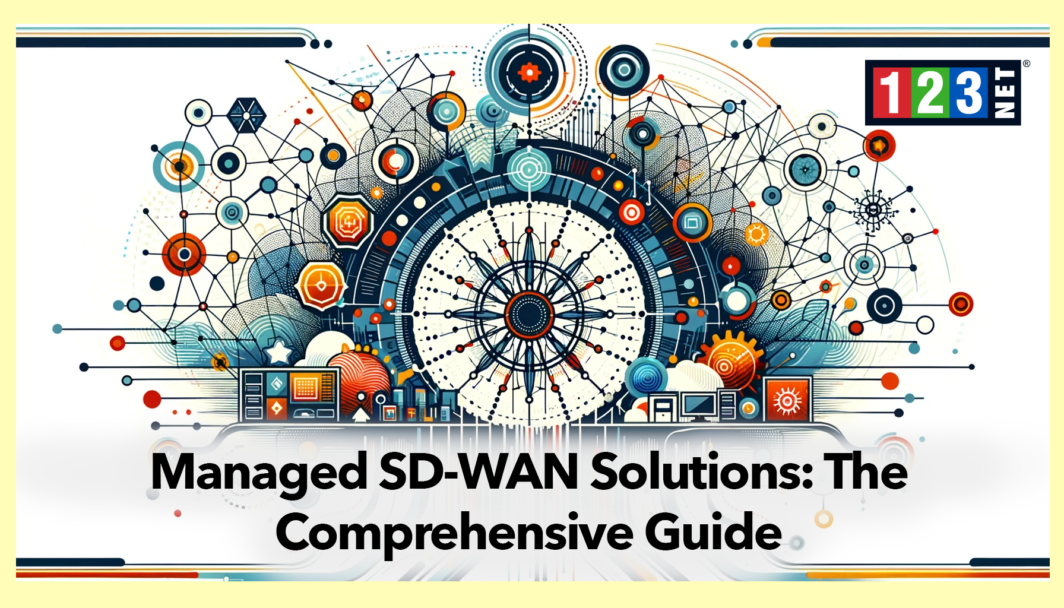
Introduction
Managed SD-WAN (Software-Defined Wide Area Network) has emerged as a transformative solution in the realm of modern networking. At its core, SD-WAN leverages software-defined networking (SDN) principles to automatically route traffic across a wide area network (WAN) in the most efficient way possible. This innovation is particularly important in today’s digital age where cloud networking and the Internet of Things (IoT) are paramount. This is requiring robust, flexible, and secure connectivity. Managed SD-WAN services offer businesses the opportunity to outsource the complexity of managing a WAN. This is enabling them to focus on their core activities while enjoying improved bandwidth management, quality of service (QoS), and network security.
Understanding SD-WAN Technology
Software-Defined Wide Area Networking (SD-WAN) emerges as a cornerstone technology that fundamentally transforms the management and optimization of network traffic. By transitioning from a reliance on physical network hardware to software-driven control, SD-WAN ushers in an era of unparalleled flexibility and command over network operations. This shift allows for the seamless distribution of network resources. It is ensuring that critical applications obtain the necessary bandwidth and performance to function optimally. Among its standout features, application-aware routing and dynamic path selection are particularly noteworthy. These capabilities enable the network to intelligently prioritize traffic and adapt routing decisions in real-time based on the current network conditions. Thereby enhancing overall efficiency and user experience.
Contrasting sharply with traditional Wide Area Network (WAN) solutions, SD-WAN deviates from the historically hardware-focused. Inflexible architectures typified by Multi-Protocol Label Switching (MPLS). While MPLS has been celebrated for its high reliability and quality of service, it falls short in terms of flexibility and cost-efficiency. Especially in scenarios demanding robust cloud networking solutions and the incorporation of network function virtualization (NFV). The introduction of SD-WAN marks a significant departure from these constraints. It is providing a scalable, secure, and cost-effective alternative that better suits the dynamic needs of today’s businesses. This technology facilitates a more agile and responsive network infrastructure. Capable of adjusting to the ever-changing demands of cloud-based applications and services. Thereby ensuring that enterprises remain at the forefront of technological innovation and efficiency. With SD-WAN, organizations can now enjoy enhanced connectivity that not only meets but anticipates the evolving requirements of the modern digital landscape.
Why Opt for a Managed SD-WAN Solution?
In the contemporary digital era, the intricate tapestry of modern networks, coupled with an escalating dependence on cloud services. As well as the proliferation of the Internet of Things (IoT), poses significant challenges for organizations worldwide. Navigating this complex landscape necessitates a sophisticated yet streamlined approach to network management—a criterion adeptly fulfilled by managed Software-Defined Wide Area Network (SD-WAN) solutions. By offering a paradigm of centralized control and visibility, managed SD-WAN significantly demystifies network management. This methodology not only augments network performance and fortifies security but also stands out as a more economically viable and expansible alternative compared to traditional network management strategies.
Opting for a managed SD-WAN service empowers businesses with the expertise required for the meticulous deployment and continuous oversight of their network infrastructure. This service encompasses cutting-edge functionalities such as zero-touch provisioning and application-aware routing. Ensuring the network’s seamless operation under varying demands and potential security threats. Such adaptability obviates the need for incessant intervention by an organization’s IT personnel. Thereby freeing up valuable resources and reducing operational complexities.
The unparalleled service level and scalability afforded by managed SD-WAN render it an immensely appealing choice for companies. It is aspiring to upgrade their network infrastructures. It elegantly addresses the quintessential need for a modernized network that seamlessly accommodates the dynamic requirements of cloud computing. As well as IoT integration, without imposing the additional burdens of complexity and expenditure. Consequently, managed SD-WAN emerges as a cornerstone technology for organizations striving to thrive in the digital age. It is providing them with a robust, adaptive, and cost-efficient network infrastructure capable of steering through the challenges of modern digital connectivity.
Key Components of Managed SD-WAN Services
Managed Software-Defined Wide Area Network (SD-WAN) services amalgamate several pivotal components, crafting a holistic solution that redefines network management. At the heart of this innovative approach lies centralized control and visibility. It is offering network administrators a unified dashboard—a “single pane of glass”—for comprehensive monitoring and management of network performance across diverse locations. This centralized oversight is instrumental in sustaining high-quality service (QoS) levels and in prioritizing bandwidth and resources for mission-critical applications. This is ensuring they operate at peak efficiency without interruption.
Another foundational element of managed SD-WAN is application-aware routing. This feature intelligently tailors the network’s behavior to meet the unique requirements of individual applications. By dynamically adjusting resource allocation and routing based on application needs, it significantly enhances network performance and user experience. This is particularly beneficial in environments where varying applications have distinct priorities and bandwidth demands.
Complementing these features, zero-touch provisioning represents a quantum leap in network deployment and expansion ease. It streamlines the setup of new sites or services by automating many of the processes involved. It is markedly reducing the need for extensive technical intervention. This capability not only accelerates network expansion but also lowers the barrier to entry for deploying advanced network infrastructures. this is making it simpler and more efficient for organizations to scale their operations.
Together, these components form the backbone of managed SD-WAN services, offering a robust, flexible, and user-centric networking solution that meets the demands of modern enterprises and simplifies complex network management tasks.

Choosing the Right Managed SD-WAN Provider
Choosing the appropriate managed Software-Defined Wide Area Network (SD-WAN) provider is a decisive step towards realizing the full potential of your network transformation efforts. This decision should be informed by a thorough assessment of several critical factors. This is to ensure that the selected provider aligns with your organization’s strategic goals and technical requirements. Initially, the provider’s experience in deploying these solutions across similar industries or businesses sizes offers a glimpse into their capability to handle your network complexities and challenges effectively.
The scalability of the provider’s solution is another paramount consideration. It’s essential to partner with a provider whose services can grow in tandem with your business. As well as accommodating future expansion without necessitating a complete overhaul of the existing network infrastructure. This ensures a long-term, sustainable networking solution that can adapt to evolving business needs.
Moreover, the provider’s commitment to network security cannot be overstated. With cyber threats becoming increasingly sophisticated, opting for a provider that offers robust security measures. This is including virtual private network (VPN) capabilities and advanced threat protection, is vital for safeguarding your data and applications.
Lastly, evaluating the service level agreements (SLAs) offered by the provider is crucial. SLAs detail the provider’s promises regarding network uptime, performance metrics, and support responsiveness. These agreements serve as a benchmark for the service quality you can expect. As well to provide a legal recourse in case of service shortcomings.
Implementation and Management of Managed SD-WAN
Implementing a managed Software-Defined Wide Area Network (SD-WAN) solution is a process that demands strategic planning in execution. The success of this implementation hinges on customizing deployment strategies. This is to dovetail with the unique requirements and pre-existing infrastructure of the business. This bespoke approach ensures that the transition to a managed SD-WAN not only integrates seamlessly with the current network setup but also leverages its strengths to enhance overall performance and efficiency.
Upon deployment, the journey towards achieving a fully optimized network is far from over. The role of ongoing management and support provided by the SD-WAN provider becomes pivotal. This continuous oversight is essential for maintaining the network’s resilience against disruptions and security threats. Thereby safeguarding critical business data and applications. The provider’s expertise ensures that the network infrastructure is not only robust but also flexible enough to adapt.
Such adaptability is crucial in today’s rapidly evolving digital landscape. Where new technologies and cyber threats emerge at an unprecedented pace. The managed SD-WAN provider’s commitment to regular updates, proactive monitoring, and immediate response to issues ensures that the network infrastructure remains state-of-the-art. To secure, and perfectly attuned to the organization’s growth trajectory and evolving needs. This partnership between businesses and their managed SD-WAN providers is foundational to achieving a dynamic, secure, and future-proof network infrastructure.
FAQs
- What is the difference between SD-WAN and MPLS? A: SD-WAN offers more flexibility and cost-efficiency by using the internet to connect sites, while MPLS is a more traditional, private WAN connection known for its reliability and quality of service.
- How does SD-WAN enhance security? A: SD-WAN improves security through encrypted connections, segmented network traffic, and integrated security features that protect against a wide range of cyber threats.
- Can SD-WAN replace MPLS? A: For many organizations, SD-WAN can replace MPLS, especially when prioritizing flexibility, cost savings, and cloud integration. However, some may choose a hybrid approach, combining both technologies.
Conclusion
The future of managed SD-WAN looks promising, with emerging trends such as the integration of artificial intelligence (AI) in networking poised to further enhance network management and efficiency. AI and machine learning can automate complex decision-making processes, improving application performance management (APM) and further simplifying network operations.
As businesses continue to adopt cloud services and expand their IoT deployments, the role of managed SD-WAN services will become increasingly critical. These services not only offer the agility and scalability needed to support such trends but also ensure that networks remain secure and efficient in the face of ever-evolving challenges.




